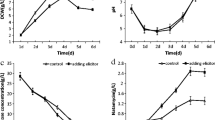Summary
A soil isolate ofStreptomyces roseosporus was found to produce spores in stirred submerged culture. Both biological mass and respiratory activity increased during the sporulation process. Contrary to other reports, the differentiation process was not purposefully initiated by critical manipulation of either nutritional or environmental conditions.
Similar content being viewed by others
References
Becker, B., M.P. Lechevalier, R.E. Gordon and H.A. Lechevalier. 1964. Rapid differentiation betweenNocardia andStreptomyces by paper chromatography of whole-cell hydrolysates. Appl. Microbiol. 12: 421–423.
Efremenkova, O.V., L.N. Anisova and A.S. Khokhlov. 1979. Excretion by various actinomycetes of substances that induce sporulation in an asporogenic mutant ofStreptomyces griseus. Mikrobiologiya 48 (6): 999–1003.
Ensign, J.C. 1978. Formation, properties, and germination of actinomycete spores. Annu. Rev. Microbiol. 32: 185–219.
Huber, F.M., R.L. Pieper and A.J. Tietz. 1987. Dispersal of insoluble fatty acid precursors in stirred reactors as a mechanism to control antibiotic factor distribution. In: Biotechnology Processes — Scaleup and Mixing, pp. 239–243. American Institute of Chemical Engineers, New York.
Kendrick, K.E. and J.C. Ensign. 1983. Sporulation ofStreptomyces griseus in submerged culture. J. Bacteriol. 155: 357–366.
Kondo, S., M. Katayama and S. Marumo. 1985. Carbazomycinal and 6-methoxycarbazomycinal as aerial mycelium formation inhibitory substances ofStreptoverticillium species. J. Antibiot. 39 (5): 727–730.
Kuester, E. and S.H. Attaby. 1982. Formation of fertile aerial mycelium within asporogenous streptomycetes as induced by fungal metabolites — isolation and partial characterization of stimulatory factor produced byCladosporium cladosporioides andDrechsiera erythrospila. J. Allg. Mikrobiol. 22: 107–17.
Liu, C., B.M. Pogell and P.A. Redshaw. 1985. Regulation of ‘conditional’ aerial mycelium mutants of Streptomycetes. J. Gen. Microbiol. 131: 1015–1021.
McCann, P.A. and B.M. Pogell. 1979. Pamamycin: a new antibiotic and stimulator of aerial mycelkia formation. J. Antibiot. 32 (7): 673–678.
Omura, S., Y. Takahashi, Y. Awai and H. Tanaka. 1982.Kitasatosporia, a new genus of the orderActinomycetales. J. Antibiot. 35 (8): 1013–1019.
Author information
Authors and Affiliations
Rights and permissions
About this article
Cite this article
Huber, F.M., Pieper, R.L. & Mertz, F.P. Sporulation ofStreptomyces roseosporus in submerged culture. Journal of Industrial Microbiology 2, 235–241 (1987). https://doi.org/10.1007/BF01569545
Received:
Revised:
Accepted:
Issue Date:
DOI: https://doi.org/10.1007/BF01569545




